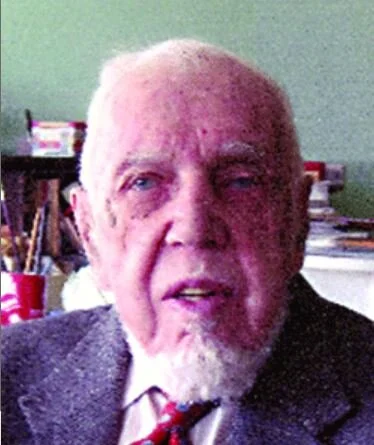John B Lear Jr (1910 - 2008)
Artists Web Bio | View Artwork
Everything my brushes or pencils produce becomes a natural ingredient. Being a longtime Anglophile, my landscapes are largely Great Britain-inspired and are records of what my eyes have seen and my mind remembered. The illustrator in me creeps into both figure work and landscapes, I hope as an adjunct and not an intrusion. Recently I have added still life to the figure work and landscapes.
John Lear has been an active artist for over 70 years. From his early social realist works of the 1930s to his surrealist visions of the forties, which recall the desolation and destruction of World War II, he has developed a mysterious idiosyncratic personal style. He classifies his work as "records" and "creations." The records are those images, mostly landscapes, which he finds in nature and records by the camera: the artist as objective observer. While stimulated by photographs taken on site, he will intensify or exaggerate the sky or shadows to present an "other-worldly" sensation, thus bridging the division between his "records" and "creations."
His "creations" are composites of realistic yet disparate images in dream-like landscapes. After an exhibit at the Philadelphia Art Alliance in 1943 of his early Daliesque paintings, one critic described Mr. Lear as "the Philadelphia surrealist." His more recent paintings of idealized male figures, reminiscent of the classical Greek form, displaying their youthful bodies amidst a landscape littered with architectural fragments and broken shards, suggest hope and reconstruction.
Many of Mr. Lear's images are drawn from memory, using his own photographs and sketches of the figure or animal illustrations as aids. Regardless of subject matter, his primary concern is with formal concepts: composition, color, and the proximity of the images to the edge of the painting. He is adamant that his pictures tell no stories: of one watercolor he says, "Why the goldfish is floating in mid-air – I'm afraid I haven't got an answer." Rather, he is concerned that the juxtaposition of his figures and objects pique the viewers' imagination. These paintings are a tour de force of Mr. Lear's illustrative talents: figures now share landscapes populated by animals of ominous mien and by intensely colored banners suggestive of medieval pageantry. Similarly, the circus celebration – a little "out of this world" – provides a perfect setting for Mr. Lear's art

